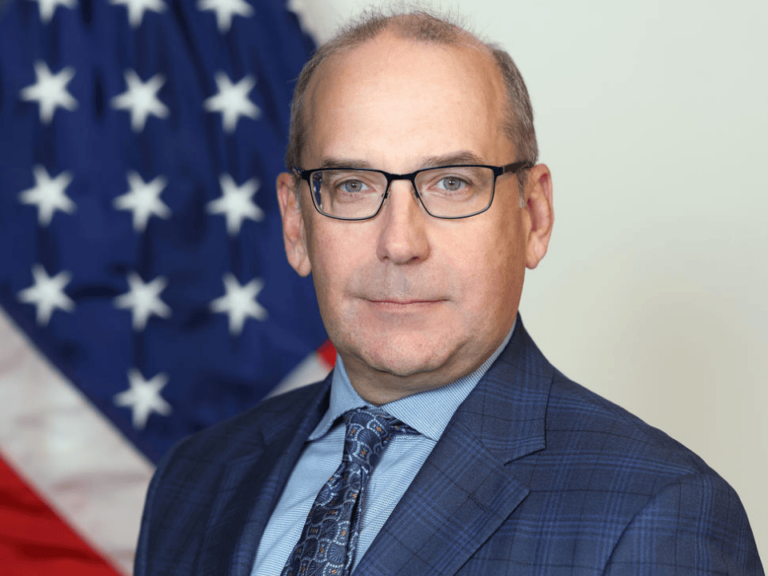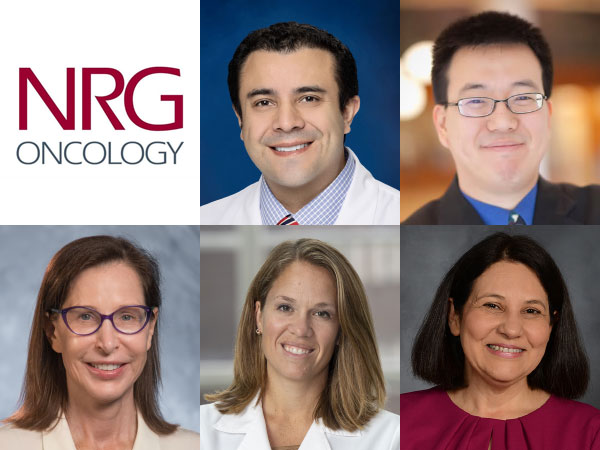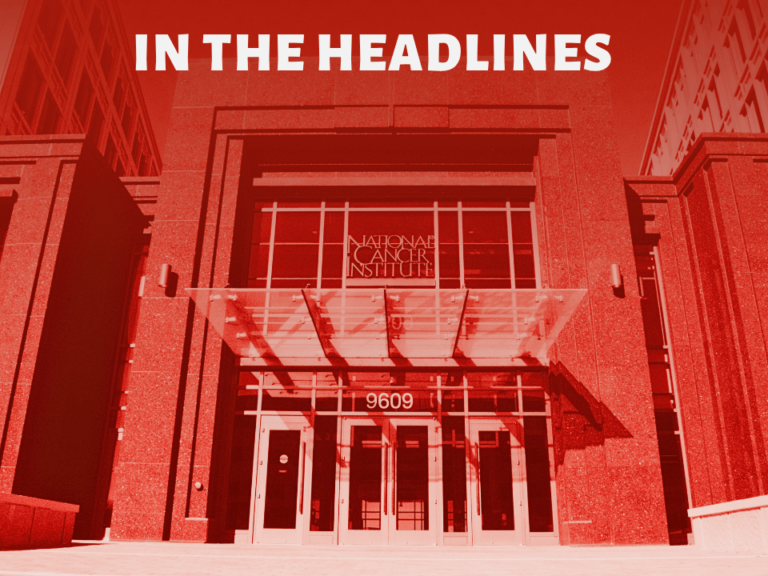Kate Choi grew up hearing conversations about skin cancer. Her grandparents had it, as did her cousins.
This family history with skin cancer prompted Choi to look into dermatology databases, where she noticed a dearth of data on patients with darker skin tones. Also, she learned that Black and Asian patients with melanoma have poorer prognoses than white patients with the disease.
“There’s this common misconception that people with darker skin won’t get skin cancer,” said Choi, a student at the Potomac School in McLean, VA, who recently competed in the Regeneron International Science and Engineering Fair in Los Angeles. “There’s just an extreme lack of data on basically any race or any person with dark skin.”
Choi, who is Korean American, is no ordinary 17-year-old. The rising high school senior has a passion for scientific research—and is precisely the sort of young person that industry and NCI want to keep on track in their pursuit of science.


Photo credit: Courtesy of Kate Choi
In May, Choi, who developed an AI-based algorithm to detect skin cancer on darker skin tones, joined nearly 2,000 other student scientists at Regeneron ISEF, the world’s largest pre-college science competition.
“Racial justice is just something that I’m very passionate about, especially at the intersection with medical fields,” Choi said to The Cancer Letter. “So, I thought [competing in science fairs] was a great way for me to express my work and get some acknowledgment.”
ISEF’s title sponsor, Regeneron Pharmaceuticals Inc., funds the competition to excite high school students about research and to elevate award winners as role models—all to build the next generation of scientists, said George Yancopoulos, president, chief scientific officer, board co-chair, and co-founder of Regeneron.
“We recognize that there’s going to be so much need, and these kids are going to have to figure a lot of things out,” he said to The Cancer Letter. “We need the next generation.”
NCI, too, plays a role in inspiring future scientists. The institute’s Youth Enjoy Science program funds educational and research-based activities for students from underrepresented backgrounds to inspire them to pursue careers in cancer research.
“We believe in the power of early intervention—planting seeds—and we understand that there is a need to reach younger minds,” said Behrous Davani, chief of the NCI Center to Reduce Cancer Health Disparities Diversity Training Branch, which oversees the YES program. “We hope that we can see the fruits in 10, 15, 20, 30 years.”
Designating science heroes
Yancopoulos was 13 when his grandmother developed Alzheimer’s disease.
“She basically raised me,” Yancopoulos said, explaining her pivotal role in the Greek immigrant family. “That helped motivate me to say, ‘Hey, I want to become a scientist and cure Alzheimer’s.’”
In high school, Yancopoulos started studying a protist genus’s regenerative abilities, hoping to one day regenerate neurons in humans. That project earned Yancopoulos ninth place at the 1976 Science Talent Search, which is currently known as the nation’s oldest and most prestigious science competition for high school students.
STS is run by the Society for Science, the same non-profit that operates ISEF. Now, both of these competitions are sponsored by Regeneron.
Yancopoulos sees his company’s sponsorship as a way to back the experience that kicked off his career.
“To think that a bunch of serious top scientists thought I was good enough to get to the highest levels and even be a winner gave me confidence,” Yancopoulos recalled. “Maybe I could do this. Maybe I could really be a scientist.”
Winning an award at STS was a big deal at his high school.
“At most schools, the heroes are the captains of the football team,” Yancopoulos said. “But at the Bronx High School of Science, the real heroes are the kids who win these science competitions.”
STS has been designating the heroes that young Yancopoulos admired since its founding in 1942.
Originally sponsored by the Westinghouse Electric Corporation, the competition provides a stage for U.S. high school seniors to present original research. Today, nearly 2,000 students enter the competition each year, and 40 finalists come to Washington, DC, in March to compete for awards that include a first-place prize of $250,000.
Similarly, ISEF started in 1950 and was also first sponsored by Westinghouse. Each May, the international competition hosts around 2,000 finalists who have moved forward from local and regional fairs. These finalists gather in a U.S. city to compete for about $9 million in prizes, including a top award of $75,000.


Photo credit: Erin Song
Sometimes, these competitions provide lessons in scientific integrity. This happened at the most recent competition, soon after one finalist was named one of this year’s $50,000 Young Scientist Award winners.
The Society for Science “received allegations regarding the scientific integrity” of the research project, the society said in a press release. “Per the society’s defined process, a thorough investigation was immediately conducted,” and the contestant ultimately “opted to withdraw his project and decline the awards,” the press release said.
Although the competitions center around prestige and monetary awards, many ISEF finalists, including Choi, find the personal connections and experiences much more valuable.
“They do give out awards here, and all that,” Choi said. “But I just think that being able to come here is a great opportunity in itself because of how special it is.”
Choi took home a third-place prize in the biomedical and health sciences division for her skin-cancer detecting AI algorithm.
She is now finessing the hardware portion of the project, a low-cost device to image a skin lesion in question for testing by her algorithm. The algorithm provides three possible outcomes: benign, malignant, or needs further testing.
“One of these hardware devices can serve an entire community of people that does not have access to immediate health care,” Choi said.
Choi plans to pursue a research career at the intersection of biomedical science and health equity, although she is concerned about her future with NIH facing potential budget cuts—especially in an era of increasing distrust in science (The Cancer Letter, April 12, 2024).
Federal funding for scientific research seems to be largely a question for another day for ISEF finalists.
“The thing that I really love is the enthusiasm that I’m surrounded by—there are so many cool student projects,” said another competitor, Erin Song, a recent graduate of Horace Greeley High School in Chappaqua, NY. “I really appreciate how everyone here is so dedicated to their craft and their science.”
Song presented research on a novel method to identify potential drug targets for cancer treatment, and evaluation of a protein she found that could be an actionable treatment target for non-small cell lung cancer. Her project received fourth place in the biomedical and health sciences division.
“I’ve always been really interested in science, and specifically cancer,” she said. “Cancer is going to be a disease that will plague humanity for a long time.”
Song plans to pursue a pre-medical track when she starts at Georgetown University this fall, and ultimately go into health care administration.
Her career choice has been shaped by the people she met at ISEF and other competitions, she said. And Yancopoulos, in particular, left a lasting impression on her.
“He was once a student researcher,” Song said. “Being able to see someone who was once in my shoes be so successful is just really inspiring.”
Paying it forward
Both ISEF and STS have faced peril over the last 30 years. Westinghouse, which was failing in the 90s, handed over title sponsorship to Intel in 1997. That tech company stopped sponsoring STS less than a decade later, in 2016.
When news broke that Intel was ending its sponsorship, Yancopoulos and Leonard Schleifer, president, CEO, board co-chair, and co-founder of Regeneron—and a one-time STS contestant—went to their company’s board to urge for Regeneron to take over.
“We were a much smaller company [at the time], and we really didn’t have the resources to do it,” Yancopoulos said. “But we also didn’t want it to die.”
The board shared Yancopoulos and Schleifer’s fervor for the competitions. “Everybody was all in. This was a national treasure, something that was so critical for generations of scientists, and we wanted it to keep going,” Yancopoulos said.
In 2016, the pharmaceutical company dedicated $100 million to STS over the next 10 years, and 2017 marked the first year of Regeneron STS.
“We’re a science-led and a science-driven company, and we feel like it’s our duty, our obligation, and our responsibility to pay it forward,” Yancopoulos said.
Additionally, 2020 became the first Regeneron ISEF, after the company dedicated $24 million to ISEF for a five-year period starting in 2019. In 2023, Regeneron added another $34 million commitment to the international competition over the next five years.
“It’s such a great full-circle story that two kids who were engaged and inspired by these very competitions are now the sponsors of the competitions,” Yancopoulos said. “I’m hoping that these kids end up with the same sort of full-circle stories.”
Elevating students
Competing in science fairs requires time, money, mentorship, and other resources, and for some students, conducting original research is simply not feasible. Only a small proportion of America’s more than 20,000 high schools can support student research.
“Unfortunately, only a few thousand [high schools] have [research] programs and consistently produce kids who compete at these levels,” Yancopoulos said.
“So, what we’re trying to do—and a lot of the investment that we make—is going to try to engage and help and elevate some of the schools that don’t have histories of programs,” he said.
For instance, Regeneron has partnered with Cold Spring Harbor Laboratory to open an education center with laboratories for middle and high school students. The company also sponsors a research program for students attending Yonkers public high schools.
NCI, too, has been investing in the next generation of researchers at a young age. The institute has sponsored YES programs at various institutions around the country since 2017, having contributed about $41 million to the enterprise so far. They are part of the Continuing Umbrella of Research Experiences program, an initiative of NCI’s Center to Reduce Cancer Health Disparities.
These programs support middle school, high school, and undergraduate-level research and educational activities to increase diversity in the cancer workforce. “The program components are designed to instruct and attract [students] to cancer research as a career path, and also to engage with the community,” Davani, of the NCI center’s Diversity Training Branch, said to The Cancer Letter.
The mission also aligns with NIH’s goals to build minority health and reduce health disparities, said Sangeeta Ghosh, a program director at the NCI CRCHD DTB. “Diversifying the workforce is one of the powerful strategies to reduce these kinds of disparities.”
NCI has supported more than 1,500 students—about 850 of whom were high schoolers—through 24 YES programs, Davani, Ghosh, and JoBeth McCarthy, a program director at the NCI CRCHD DTB, said in a statement to The Cancer Letter. In some programs, more than 90% of participants are now pursuing biomedical-related degrees, according to the statement.
“We are creating a huge cohort of students that can be role models for their peers, for their neighbors, for their family members,” Davani said. “This is definitely an investment in the future, and we hope that we can nurture the program.”
Taking action
The University of Kentucky Markey Cancer Center created one such education program for young scientists in 2016 through an NCI CURE supplement. That program, called the Appalachian Career Training in Oncology Program, or ACTION, has been an NCI YES program since 2018.
ACTION’s high school portion focuses on students from counties in eastern Kentucky, specifically 54 counties in the Appalachian region.
“The reason we target those students in particular is [because] Kentucky has a massive cancer problem—first in the nation in overall cancer incidence and mortality rates for a long time,” Nathan Vanderford, director of the MCC ACTION program, said to The Cancer Letter. “And those rates are significantly greater in those 54 counties.”
Vanderford is also an associate professor in the Department of Toxicology and Cancer Biology and director of administration at the Center for Cancer and Metabolism at UK, and assistant director of Pathway Programs and Student Success at the UK Markey Cancer Center.


Photo credit: University of Kentucky Markey Cancer Center
Disparities in educational attainment are acutely felt in the region, too, Vanderford said. In eastern Kentucky, 19% of people age 25 and over lack a high school degree, compared to 11% of the U.S. population, according to the Appalachian Regional Commission’s chartbook compiling data from the 2017-2021 American Community Survey. And only 16% of people in the area hold a bachelor’s degree, compared to 34% of the U.S. population.
ACTION steps in by offering a two-year program—almost 100% free, and with a stipend—for around 20 selected students in each cohort. Every month, the students visit the UK campus for a day of activities, like lectures from guest speakers and even a ballroom dance lesson in conjunction with a discussion on wellness.
The program’s main event takes place in the summer when students stay on campus for five weeks. There, they conduct research in labs they have been matched with based on their interests, attend workshops on topics including cancer biology, clinical ethics, and career development, and shadow health professionals.
“That is really where the magic happens for a lot of the students,” said Nolan Marcum, a rising senior at UK who participated in the ACTION program as a high school student and undergraduate. That summer portion is where he received mentorship from pathologist Thèrése Bocklage, who gave him the confidence to pursue a medical degree.
Marcum first applied to the ACTION program thanks to a push from teachers in his small hometown of Grayson, KY. “Neither of my parents went to college, so education wasn’t a priority at home,” he said. “A lot of the teachers knew my home situation. They were the people fighting for me in the corner that I didn’t have at home.”
He had long been interested in a career in science, but the ACTION program led him to medicine, specifically surgical oncology. The program also convinced Marcum to return to eastern Kentucky after receiving his medical training.
Previously, Marcum had hoped to escape the region due to its lack of job opportunities and educational resources. Now, he believes doing so would be a disservice to the ACTION program and future generations.
“After learning just how bad the [cancer] crisis was and learning that everybody else wants to get out, I can’t just leave,” Marcum said. “I would rather create an environment for future students to live in Appalachia.”












